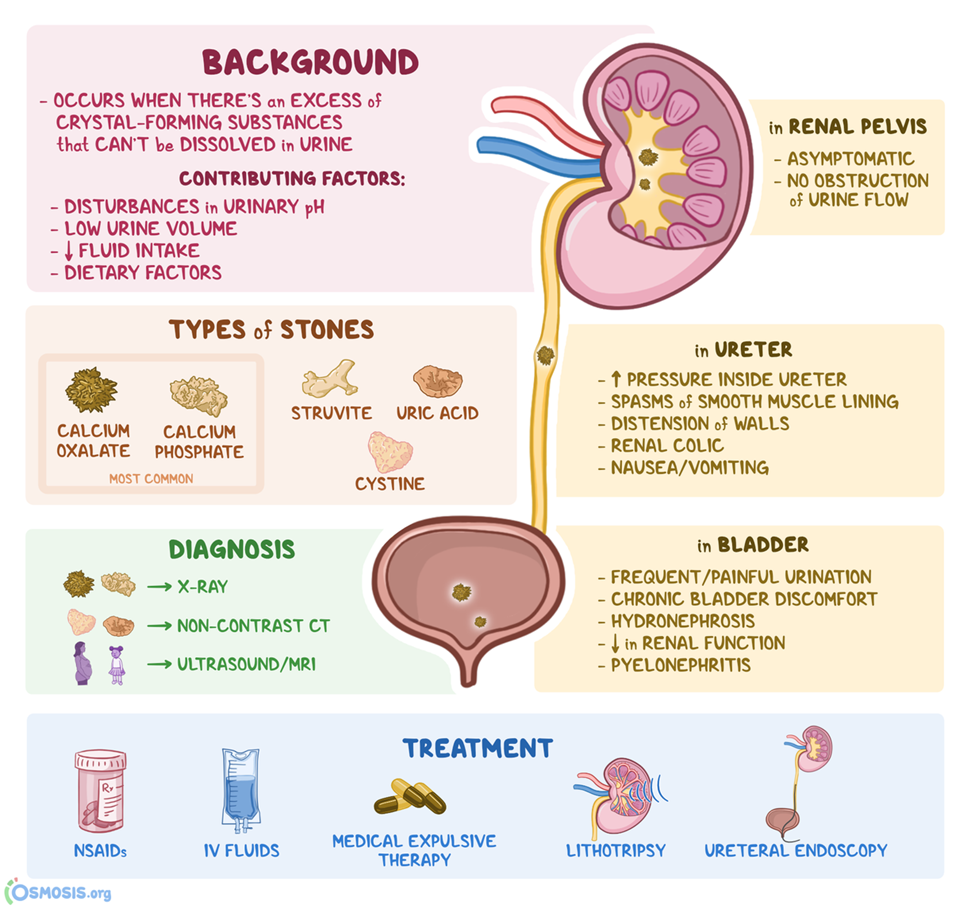A client with hyperparathyroidism reports a sudden onset of severe flank pain. Which intervention should the nurse include in the client's plan of care?
Initiate cardiac telemetry.
Administer a PRN dose of a laxative.
Implement seizure precautions
Begin straining all urine
The Correct Answer is D
A. Initiate cardiac telemetry:
Cardiac telemetry is not the immediate priority in this case. Kidney stones are more likely to cause severe localized pain rather than cardiac-related symptoms.
B. Administer a PRN dose of a laxative:
Laxatives are not indicated for the management of kidney stones or the associated flank pain. The priority is to address the specific needs related to the possible passage of kidney stones.
C. Implement seizure precautions:
Seizure precautions are not relevant to the sudden onset of severe flank pain in the context of hyperparathyroidism. The focus should be on managing pain, assessing for kidney stone passage, and addressing the underlying cause.
D. Begin straining all urine.
Straining all urine allows for the collection and examination of any passed stones. This information is important for identifying the composition of the stones and guiding further management.

Nursing Test Bank
Naxlex Comprehensive Predictor Exams
Related Questions
Correct Answer is C
Explanation
A. Evaluate upper and lower extremities for perfusion, pulse volume, and pitting edema:
This option focuses on assessing perfusion and circulation in the extremities. While it's important in certain situations, in the context of a client who recently underwent cardiac stent placement and is now experiencing chest pressure and shortness of breath, the priority is to assess the cardiac status more directly.
B. Listen for extra heart sounds, murmurs, and rhythm with the bell of the stethoscope:
This option involves auscultating the heart for abnormal sounds or rhythms. While it's a valuable assessment in general, in this particular scenario, obtaining an electrocardiogram (ECG) and initiating continuous cardiac monitoring would provide a more comprehensive and immediate evaluation of the cardiac status.
C. Obtain a 12-lead electrocardiogram and begin continuous cardiac monitoring:
This is the correct choice. Obtaining a 12-lead ECG and initiating continuous cardiac monitoring is crucial in assessing the client's cardiac function. It allows for the detection of any acute changes in the heart's electrical activity or rhythm, which is essential for timely intervention and management.
D. Verify troponin level assessments are scheduled every 3-6 hours for a series of three:
Monitoring troponin levels is important in assessing cardiac damage, but in this acute situation, obtaining an immediate ECG and initiating continuous cardiac monitoring take precedence for a more real-time evaluation of the client's cardiac status. Troponin levels may be monitored subsequently based on the initial findings.
Correct Answer is B
Explanation
A. Return appointments will be needed for IV medication:
This statement does not address the specific concern related to pain management in Raynaud's disease, and routine IV medication may not be the primary approach for pain relief in this condition.
B. Wearing gloves when handling cold items guards against painful spasms:
This is the correct answer. Raynaud's disease is characterized by vasospasm of small arteries, often triggered by exposure to cold or stress. Wearing gloves helps to minimize exposure to cold and can prevent painful spasms associated with Raynaud's.
C. Enrolling in a pain clinic can provide pain relief alternatives:
While pain clinics can offer various pain management strategies, the specific recommendation for Raynaud's disease involves minimizing exposure to cold and stress rather than enrolling in a pain clinic.
D. Painful areas should be rubbed gently until the pain subsides:
Rubbing painful areas may not be recommended, as it can potentially aggravate vasospasm in individuals with Raynaud's disease. The emphasis is on preventing triggers like cold exposure.
Whether you are a student looking to ace your exams or a practicing nurse seeking to enhance your expertise , our nursing education contents will empower you with the confidence and competence to make a difference in the lives of patients and become a respected leader in the healthcare field.
Visit Naxlex, invest in your future and unlock endless possibilities with our unparalleled nursing education contents today
Report Wrong Answer on the Current Question
Do you disagree with the answer? If yes, what is your expected answer? Explain.
Kindly be descriptive with the issue you are facing.
